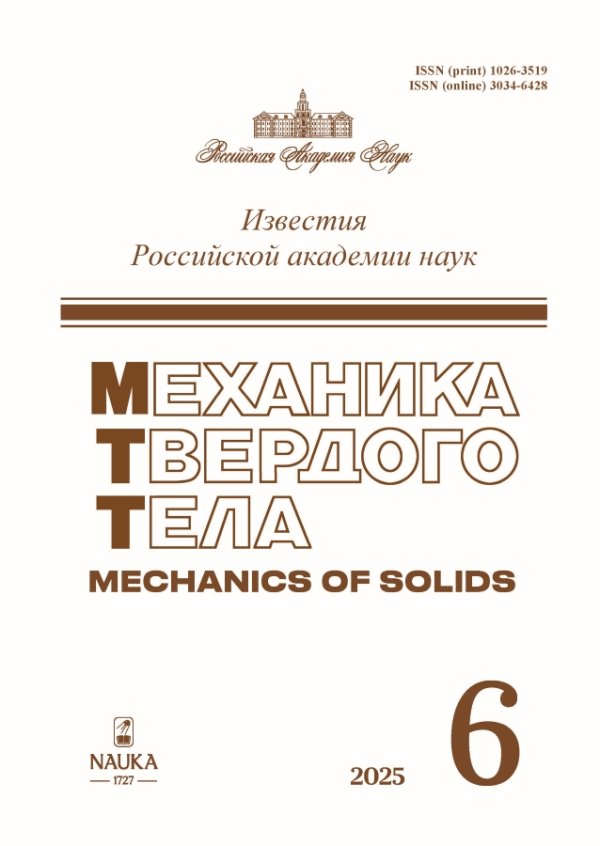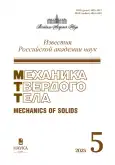Development of a complex method of studying filtration, fracturing and sand production processes in gas reservoirs of the Arctic shelf to determine optimal well operation parameters
- Authors: Khimulia V.V.1, Barkov S.O.1, Kovalenko Y.F.1, Karev V.I.1, Shklover V.Y.2, Zaytsev D.M.2
-
Affiliations:
- Institute of Problems of Mechanics named after A.Yu. Ishlinsky RAS
- LLC 'Systems for Microscopy and Analysis'
- Issue: No 5 (2025)
- Pages: 71-101
- Section: Articles
- URL: https://bakhtiniada.ru/1026-3519/article/view/315574
- DOI: https://doi.org/10.31857/S1026351925050045
- EDN: https://elibrary.ru/bvdcpr
- ID: 315574
Cite item
Abstract
The paper presents the results of a comprehensive study of fracture, filtration and sand production processes in weakly cemented reservoirs of one of the gas condensate fields of the Arctic shelf of Russia. A modified multidisciplinary scientific approach has been developed and implemented, aimed at solving the problems of ensuring safe operation of wells, justifying effective modes of their operation and reducing the sand production risks. The research methods are based on multilateral study of core material properties by means of geomechanical modeling of mechanical and filtration processes in the vicinity of wells, “hollow cylinder” tests to study sand production processes in wells, scanning electron microscopy, micromineralogy, computed tomography and digital core analysis. Special emphasis was placed on the analysis of changes in reservoir structure as a result of sand production processes, taking into account the mineral composition of the matrix and the dislodged sand. Experimental results allowed to determine for the considered field: a) evolution of deformation and filtration properties of rocks in the near-wellbore zone; b) values of critical stresses leading to wellbore wall failure; c) type and nature of rock failure; d) parameters of sand production processes and mechanisms of associated destruction of the reservoir matrix; e) reservoir properties of rocks. Based on the research results, the optimal parameters for safe and efficient well operation have been determined, including allowable drawdowns to reduce the sand production risks and maintain wellbore stability; the nature of well contour failure and the risks of damage to downhole equipment; and the optimal characteristics of downhole filters. The results of this research are intended to contribute to the development of technologies for creating new solutions aimed at improving the efficiency of hydrocarbon production, reducing the risks of sand production and wellbore wall failure, deterioration and breakdown of downhole equipment.
About the authors
V. V. Khimulia
Institute of Problems of Mechanics named after A.Yu. Ishlinsky RAS
Email: valery.khim@gmail.com
S. O. Barkov
Institute of Problems of Mechanics named after A.Yu. Ishlinsky RAS
Email: valery.khim@gmail.com
Y. F. Kovalenko
Institute of Problems of Mechanics named after A.Yu. Ishlinsky RAS
Email: valery.khim@gmail.com
V. I. Karev
Institute of Problems of Mechanics named after A.Yu. Ishlinsky RAS
Email: valery.khim@gmail.com
V. Y. Shklover
LLC 'Systems for Microscopy and Analysis'
Email: shklover@microscop.ru
D. M. Zaytsev
LLC 'Systems for Microscopy and Analysis'
Author for correspondence.
Email: valery.khim@gmail.com
References
- Ibragimova D.R., Milovanova V.V., Subbotin M.D., Petelin D.A., Vorobyev I.V. Analysis of the factors influencing sand production of poorly consolidated gas reservoirs // Exposition Oil Gas. 2022. № 5. P. 50–54 (in Russian). https://doi.org/10.24412/2076-6785-2022-5-50-54
- He X., Pang Z., Ren L., Zhao L., Lu X., Wang Y., Liu P. A critical review on analysis of sand producing and sand-control technologies for oil well in oilfields // Front. Energy Res. 2024. V. 12. P. 1399033. https://doi.org/10.3389/fenrg.2024.1399033
- Kostilevsky V.A., Dietz A.V., Bikbulatov O.V. et al. Review of current control methods with sand production during the development of oil and gas fields // Exposition Oil Gas. 2024. № 5. P. 68–72 (in Russian). https://doi.org/10.24412/2076-6785-2024-5-68-72
- Kovalenko Y.F., Ustinov K.B., Karev V.I. Geomechanical analysis of the wellbore wall breakouts formation // Mechanics of Solids. 2022. V. 57. № 6. P. 1403–1415. https://doi.org/10.3103/S0025654422060243
- Li Y.-L., Li C.-S., Tuo H., Wu B.-B., Chen C.-H. Experimental study on critical sand production pressure gradient at different production stages of high temperature and high pressure tight sandstone gas reservoir // Energy Storage. 2024. V. 6. № 4. P. e638. https://doi.org/10.1002/est2.638
- Varkas M., Papamichos E., Berntsen A.N. Experimental study of volumetric sand production with gas flow // Geoenergy Sci. Eng. 2024. V. 234. P. 212610. https://doi.org/10.1016/j.geoen.2023.212610
- Hashim M.A.H. Sand production prediction analysis in unconsolidated reservoir. B.S. Thesis. 2011. Universiti Teknologi PETRONAS, Tronoh, Perak, MYS.
- Cook J.M. The role of borehole pressure in thick-walled cylinder closure tests in sandstones // Proceedings of the 2nd North American Rock Mechanics Symposium, Montreal, Quebec, Canada, 1996. P. ARMA-96-1113.
- Araujo-Guerrero E.F., Alzate-Espinosa G.A., Chalaturnyk R. et al. Geomechanical laboratory testing for sand production characterization using 3D-printed core analogues // Geomech. Geophys. Geo-energ. Geo-resour. 2024. V. 10. P. 195. https://doi.org/10.1007/s40948-024-00854-x
- Luo W., Xu S., Torabi F. Laboratory study of sand production in unconsolidated reservoir // Proceedings of the SPE Annual Technical Conference and Exhibition, San Antonio, Texas, USA, 2012. P. SPE-158619-MS. https://doi.org/10.2118/158619-MS
- Karev V.I., Khimulia V.V., Shevtsov N.I. Experimental studies of the deformation, destruction and filtration in rocks: A review // Mechanics of Solids. 2021. V. 56. № 5. P. 613–630. https://doi.org/10.3103/S0025654421050125
- Jiang T., Yao W., Sun X. et al. Evolution of anisotropic permeability of fractured sandstones subjected to true-triaxial stresses during reservoir depletion // J. Pet. Sci. Eng. 2021. V. 200. P. 108251. https://doi.org/10.1016/j.petrol.2020.108251
- Li X., Shi L., Bai B., Li Q., Xu D., Feng X. True-triaxial testing techniques for rocks-State of the art and future perspectives. In: Kwaśniewski M., Li X., Takahashi M. (Eds.), True Triaxial Testing of Rocks, 1st ed. CRC Press/Balkema, Leiden, Netherlands, 2012. P. 3–18.
- Kwaśniewski M. Mechanical behavior of rocks under true triaxial compression conditions – a review. In: Kwaśniewski M., Li X., Takahashi M. (Eds.), True Triaxial Testing of Rocks, 1st ed. CRC Press/Balkema, Leiden, Netherlands, 2012. P. 99–138.
- Karev V.I., Kovalenko Y.F., Ustinov K.B. Geomechanics of Oil and Gas Wells. Advances in Oil and Gas Exploration and Production. Springer International Publishing Cham: Switzerland. 2020. 166 p. https://doi.org/10.1007/978-3-030-26608-0
- Younessi A., Rasouli V., Wu B. Sand production simulation under true-triaxial stress conditions // Int. J. Rock Mech. Min. Sci. 2013. V. 61. P. 130–140. https://doi.org/10.1016/j.ijrmms.2013.03.001
- Cnudde V., Boone M.N. High-resolution X-ray computed tomography in geosciences: A review of the current technology and applications // Earth-Sci. Rev. 2013. V. 123. P. 1–17. https://doi.org/10.1016/j.earscirev.2013.04.003
- Schieber J. Common themes in the formation and preservation of intrinsic porosity in shales and mudstones – Illustrated with examples across the Phanerozoic // Proceedings of the SPE Unconventional Gas Conference, Pittsburgh, Pennsylvania, USA, 2010. P. SPE-132370-MS. https://doi.org/10.2118/132370-MS
- Worden R.H., Morad S. Clay mineral cements in sandstones // Int. Assoc. Sedimentol. Spec. Publ. 2003. V. 34. P. 3–41.
- Loucks R.G., Reed R.M., Ruppel S.C., Hammes U. Spectrum of pore types and networks in mudrocks and a descriptive classification for matrix-related mudrock pores // AAPG Bulletin. 2012. V. 96. № 6. P. 1071–1098. https://doi.org/10.1306/08171111061
- Khimulia V.V. Digital Examination of Pore Space Characteristics and Structural Properties of a Gas Condensate Field Reservoir on the Basis of μCT Images // Proceedings of the 9th International Conference on Physical and Mathematical Modelling of Earth and Environmental Processes. PMMEEP 2023. SPEES. Springer, 2024. P. 23–34. https://doi.org/10.1007/978-3-031-54589-4_3
- Khimulia V.V., Karev V.I. Pore-Scale Computational Study of Permeability and Pore Space Geometry in Gas Condensate Reservoir Rocks // Proceedings of the 9th International Conference on Physical and Mathematical Modelling of Earth and Environmental Processes. PMMEEP 2023. SPEES. Springer, 2024. P. 243–256. https://doi.org/10.1007/978-3-031-54589-4_26
- Khimulia V., Kovalenko Y., Karev V., Barkov S. Determination of well stability and sand risk minimization parameters for gas condensate field conditions using geomechanical and CT-based approaches // J. Rock Mech. Geotech. Eng. 2026. V. 18. № 2. https://doi.org/10.1016/j.jrmge.2025.02.017 (Принята к печати)
- Khimulia V., Karev V., Kovalenko Y., Barkov S. Changes in filtration and capacitance properties of highly porous reservoir in underground gas storage: Ct-based and geomechanical modeling // J. Rock Mech. Geotech. Eng. 2024. V. 16. № 8. P. 2982–2995. https://doi.org/10.1016/j.jrmge.2023.12.015
- Kovalenko Yu.F., Karev V.I., Barkov S.O., Khimulia V.V. Analysis of approaches to study the influence of stress-strain state on mechanical and filtration properties of reservoir rocks // Processes in GeoMedia. 2024. № 1 (39). P. 2386–2395 (in Russian).
- Zheltov Y.P., Khristianovich S.A. About hydraulic fracturing of oil-bearing reservoir // Izvestia AN USSR. OTN. 1955. № 5. P. 3–41 (in Russian).
- Khimulia V.V., Barkov S.O. Analysis of changes in the internal structure of low-permeability reservoir rocks by means of computed tomography after implementation of the directional unloading method // Actual Problems of Oil and Gas. 2022. № 4 (39). P. 27–42 (in Russian). https://doi.org/10.29222/ipng.2078-5712.2022-39.art3
- Blumer A., Rief S., Planas B. PoroDict user guide: GeoDict release 2024. URL: https://www.math2market.com/fileadmin/UserGuide/GeoDict2024/PoroDict2024.pdf (дата обращения 11.03.2025).
- Blumer A., Rief S., Planas B. MatDict User Guide: GeoDict release 2024. URL: https://www.math2market.com/fileadmin/UserGuide/GeoDict2024/MatDict2024.pdf (дата обращения 11.03.2025).
- Gzovsky M.V. Fundamentals of tectonophysics. Moscow: Nauka, 1975. 536 p. (in Russian).
- Karev V.I., Kovalenko Y.F., Khimulia V.V., Shevtsov N.I. Parameter determination of the method of directional unloading of the reservoir based on physical modelling on a true triaxial loading setup // J. Mining Inst. 2022. V. 258. P. 906–914. https://doi.org/10.31897/PMI.2022.95
- Yakimov S.B. Peculiarities of submersible pumps operation after sand removal limitation from bottomhole zone // Equipment and technologies for oil and gas complex. 2014. № 1. P. 51–55 (in Russian).
- Saucier R.J. Considerations in Gravel Pack Design // J. Pet. Technol. 1974. V. 26. № 2. P. 205–212. https://doi.org/10.2118/4030-pa
- Martinez-Zuazo I., Fernandez M., Medina A., Segnini-Rodriguez C.J., Atienza J., Alkatiri F. Analysis of completion and production strategy for a horizontal well with open hole gravel pack. A case of study in teak field TSP, East Coast Trinidad // Proceedings of the SPE Trinidad and Tobago Section Energy Resources Conference, Port of Spain, Trinidad and Tobago, 2016. P. SPE-180904-MS. https://doi.org/10.2118/180904-ms
- Tiffin D.L., King G.E., Larese R.E., Britt L.K. New Criteria for gravel and screen selection for sand control // Proceedings of the SPE Formation Damage Control Conference, Lafayette, Louisiana, 1998. P. SPE-39437-MS. https://doi.org/10.2118/39437-ms
- Jaimes M.G., Quintero Y.A., Contreras G.Y. Drawdown management: a technical and economic alternative for sand control in wells: a Colombian field application // Proceedings of the SPE Latin America and Caribbean Petroleum Engineering Conference, Maracaibo, Venezuela, 2014. P. SPE-169376-MS. https://doi.org/10.2118/169376-ms
Supplementary files










